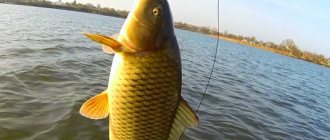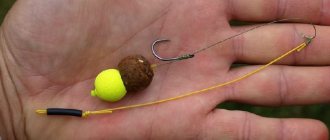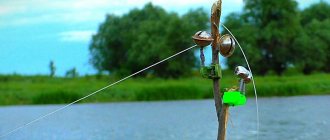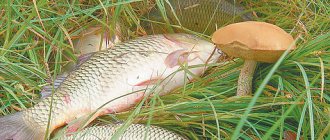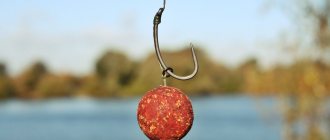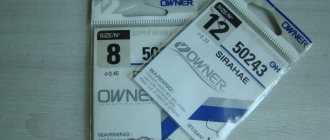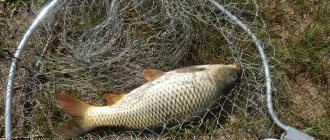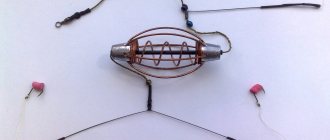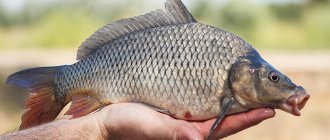Gear device
As mentioned earlier, donka - zakidushka is a classic version of donka.
Most fishermen pay attention to it for its affordability and simplicity. The gear structure is simplified as much as possible and consists of the following design:
- a reel or an ordinary wooden plank;
- sinker, on average 30-120 grams;
- braided or monofilament fishing line;
- hooks for carp, carp.
Important! Attention should be paid to the following fact. The fishing line must have a cross-section of more than 0.3 mm, otherwise, if at least a medium-sized carp is caught, the angler may cut his hands or completely lose his tackle, and with it the fish.
Features of the tackle
Of course, the main feature and at the same time advantage of this type of gear is its low cost and simplicity of design. No rod is used for rigging at all. Fishing for pike with a hook is also distinguished by its versatility in relation to the fishing location. After all, the installation can be done both in a still body of water and on a river with a current only by manipulating the size of the load.
Important! When using a pole to help cast and retrieve equipment from the water, you can fish not only in clear waters, but also at short distances in places with thickets, with gaps and algae-free windows.

The casting and reeling of the equipment onto the reel itself does not require mastering any specific technique, but is done with techniques familiar to everyone in everyday life. Both live bait and fixed bait are used as bait, which absolutely does not affect the fishing technique. And we have already mentioned the mobility of zakidushki and their transportability in our material, attributing these features to the same numerous advantages.
Advantages and disadvantages of donkey-tuck
The advantages of such gear. Casting for carp certainly has its advantages, which is why it is becoming popular among fishermen:
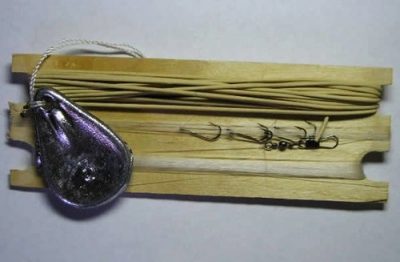
you can make long casts up to 150 meters from the shore;- even with a strong current, the equipment falls to the bottom and can remain there for the required amount of time;
- Due to the fact that the bait is located next to the hook with the bait, there is a high probability that the fish will definitely bite.
It is noteworthy that when fishing in this way, there is absolutely no need to constantly monitor the entire process. It is enough to hang a bell or any other signaling device and be nearby. This is incredibly convenient, because in fact, a bite can occur very rarely, up to once every few hours.
Flaws. Despite the fact that this method is considered quite catchy, it also has its negative aspects:
- The gear has absolutely no sensitivity. Changes can only be observed when the fish has already been spotted. Therefore, for lovers of a more dynamic type of fishing, this tackle is not suitable;
- there is practically no chance of catching a large fish, especially if it is a carp weighing more than 5 kg. The problem is that this is a fairly strong fish, so without a good rod and a spinning reel, most likely you won’t be able to catch the catch.
Lure
If in small reservoirs the fish population in the fishing area is large and there is no need to bait fish, then in large reservoirs it is impossible to do without complementary feeding.
To feed catfish, they use the meat of shells strung on skewers. They use dry complementary foods using semolina and fishmeal. Some fishermen add crushed locusts.
You can use commercial bait, such as Traper. Read more about this bait in a special article.
Carp prefer a variety of complementary foods depending on the time of year. Conventional homemade bait consists of ground seeds, crackers, grains, corn flour, and flavorings. But it is preferable to use proven baits from well-known manufacturers. The mixture chosen in them is balanced and very attractive to carp. Carp loves corn, hemp, various vegetable oils and cereals. Carp need a lot of complementary food. If the complementary food is to your liking, the carp will eat it very quickly. It’s not for nothing that they call him “piglet” or “vacuum cleaner”. When catching carp with boilies, they feed it with boilies and pelets.
Crucian carp, unlike carp, can quickly get enough of complementary foods, so to keep them in the fishing place, they use mixtures that allow them to be retained with aromas, but not to get enough. Each crucian fisher prefers to prepare complementary foods on their own, experimenting with the ingredients. The base mixture includes rolled oatmeal, breadcrumbs (breadcrumbs can be used), bran, milk powder, millet, semolina, and ground seeds. You can add flavorings.
The components of bait for bream depend on the fishing conditions (still water or river with a strong current). The color of complementary food for bream is important. It should not stand out from the color of the bottom. The main composition of complementary foods: cake (flax, sunflower, hemp, pumpkin), breadcrumbs, bran (baking powder), dry ground peas, wheat flour. Various essential vegetable oils are used as flavoring agents.
Complementary food for crucian carp and bream can also be used ready-made, with selected ingredients. But you should be careful when using ready-made bait mixtures. Practice shows that little-known baits can cause the opposite effect and scare away fish from the fishing spot.
Features of catch fishing
It’s worth noting right away that catch fishing can be done at any time of the year. The main condition is the absence of ice on the reservoir and the presence of fish in it.
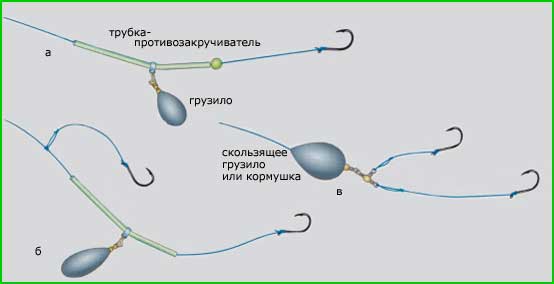
To increase the efficiency of this type of gear, it is necessary to throw several pieces at once. With one bait, you can sit for a long time waiting for a bite and get a very modest catch all day. Professional fishermen throw 10 or more gear at the same time. In this way, it is possible to fish a promising place as efficiently as possible.
This type of gear will also be relevant when fishing in water areas with thickets or snags. This is due to the fact that it is almost impossible to lose equipment in such places. Among other things, with a casting rod it is comfortable to fish in the bushes, where it is not very convenient or extremely difficult to cast a float rod.
When recasting, immediately lay down the fishing line correctly on the shore. It is best to do this in circles so that later it does not get tangled and the angler does not waste time untangling it.
Fishing technique
- Mix the complementary foods.
- We measure the depths for a suitable place for fishing (while the complementary food is infused). These can be edges, the border of strong and weak currents, whirlpools, capes.
- We feed at the fishing spot. Feeding can be done using a rocket, spomb or an existing feeder, filling it loosely. If there is a current, feeding must be done above the fishing point.
- After feeding, we fill the feeder with complementary foods, compacting the latter, and throw in the equipment with complementary foods and bait.
- If there is a current in the reservoir, then it is necessary to cast the equipment upstream of the fishing point. The optimal angle between the coastline and the tensioned main line is 45-50 degrees.
- After casting and tensioning the line, we attach a bite alarm to the rod placed on the stand.
- If after an hour there is no bite, we select a tackle to check the bait and experiment with it. Perhaps the wrong fishing spot was chosen or complementary feeding is not working.
- If the alarm goes off, you must immediately hook the fish and begin landing.
How to make a carp bait with your own hands?
Installation of the zakidushka is so simple that you can do it yourself:
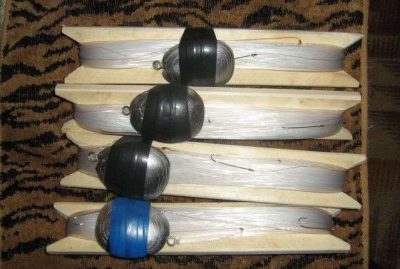
It is enough to take no more than 50 meters of the main line. Most often they use braided cord or monofilament. This length will be enough, because if you take more, you won’t be able to cast far, especially without a reel and rod.- You will need to attach a sinker to one end. As for the shape, it is necessary to take as a basis the strength of the current, the features of the bottom and other fishing conditions.
- Next, you need to tie the leash to the main fishing line, approximately at a distance of 35 to 65 cm from the load. The leash should be a little thinner, for example with a cross-section of 0.2 mm. As for the length of the leash, the best option would be a length from 25 to 45 cm.
- We knit a hook.
Now the snack is ready. If you wish, you can tie another leash, but you need to understand that in this case, the risk of tangling the fishing line will sharply increase.
Choosing bait and bait
It is very important to choose the right baits, as they should not only match the taste preferences of carp and carp, but also sit tightly on the hook. You should immediately throw aside the pearl barley, dough, peas, mash and semolina. They will fly off at the casting stage. It is best to choose harder baits, such as:
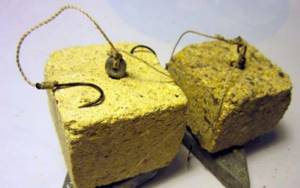
cake;- boilie;
- maggot;
- pellets;
- worm;
- corn, etc.
How to catch with a hook?
Not every angler knows how to cast a bait correctly. There is no difficulty in this if you install it correctly.

First you need to choose the right place on the shore where you can drive in a holder or something to attach the gear.- Now you need to tie the tackle to the holder - a support or fix the reel. Moreover, the latter option will be even more convenient, since at any time you can tighten the fishing line by winding it on the reel. Be that as it may, the fishing line needs to be securely fixed.
- The next step is to unwind the tackle and lay the fishing line on the shore in circles of approximately 65 cm.
- It's time to set the bait.
- You need to take the fishing line in your hands, slightly above the load, and throw it into the water.
- Now you need to attach the sound alarm to the fishing line near the support.
Options for bottom fishing gear
What kind of snacks can be made? The types and features of each design are listed below.
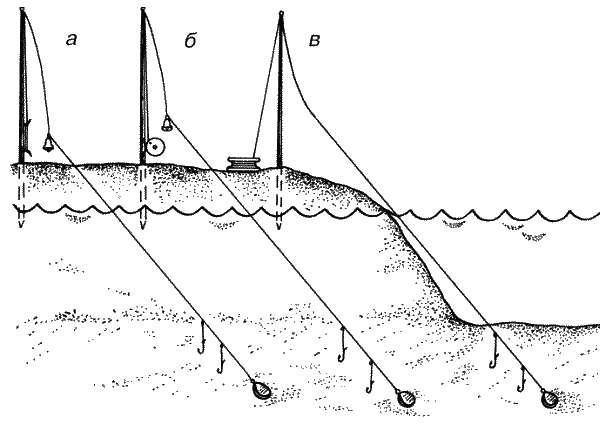
a) a zakidushka wound on a stick;
b) a bag with a reel;
c) a hook with a reel.
Zakidushka on a reel
The simplest option for throwing. Making such a snack is simple and inexpensive. There is no need to spend money on expensive spinning rods, feeders, or reels. Only fishing line, weight (feeder) and hooks are used. As a rule, several shelters are placed along the shore at once.
The main line and equipment are wound on the reel. The reel has different sizes, depending on the volume and thickness of the main line. First, the main fishing line of the required length is wound onto the reel, then a rig of leashes with hooks and a weight (feeder) is tied to the end of the fishing line.
Before casting, the tackle is unwound on the shore. The reel or fishing line is tied to a stick (stand) fixed into the ground on the shore so that when casting, all the tackle along with the reel does not fly into the pond. The other end of the fishing line with the equipment is untwisted by hand and thrown to the desired place on the pond. The free line is selected by winding it on a reel. A stretched fishing line is wrapped around a well-fixed stick on the shore or around a tree for reliable fixation when biting a large catfish. As a bite alarm, a bell is hung on the fishing line, which pulls the fishing line down, and when there is a bite, it will pull back and emit a signal.
Video of making bottom gear using a spinning rod
A spinning rod with a reel is used for convenience and casting distance. The equipment is no different from the previous version. Spinning rods for casting are used short and powerful, since casting a heavy load causes serious stress on the spinning rod blank. The spinning rod is installed at an angle to the surface of the reservoir, and a bell is attached to the tip as a bite alarm.
It’s still the same system with a sinker and hooks, which works both in the fall for pike perch and in the summer when fishing for pike.
Bottom tackle using a feeder
This bottom tackle differs from the usual casting using a spinning rod only in the presence of a specialized fishing rod with replaceable tips (feeder), which, depending on the load, act as bite alarms.
In the fall, you are guaranteed a good bite when fishing with bottom tackle if you use the above instructions.
Casting technique
It is very important to cast the bait using the pendulum method. Moreover, this is a rather responsible and important moment, so before you “fill” your hand, it is best that no one is nearby at this moment. You need to take the fishing line in your hand, approximately 1 meter from the load, and begin to unwind it. After sufficient speed has been achieved so that it has enough inertia to reach a certain area, the tackle is sent forward into the reservoir.
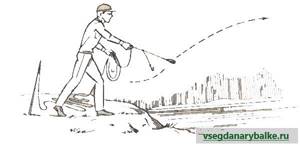
There is another, more advanced, but no less simple method. You need to take a stick with an approximate length of 65-75 cm. Put a weight on it and cast it into the desired area of the reservoir. You need to tie a loop to the weight that will be attached to the edge of the stick. Thanks to this, it is possible not only to throw the bait further, but also more accurately.
Tips for fishing
Quite often they are caught by snookers at night, which is why you need to have a good flashlight with you. This is necessary for proper placement of maggots and other bait. The most convenient option is a cap flashlight, which is attached to the visor.

In specialized stores you can find hats that already have lanterns sewn into them. You can also use lamps on the shore, but they will have to be turned off constantly so that the carp is not afraid of bright lighting.
Before heading to a new body of water, it is advisable to learn as much as possible about it. To do this, it is important to communicate directly with those fishermen who permanently reside there. Moreover, these can be not only fishermen on the shore, but even sellers in stores, because often local residents near the reservoir spend their weekends fishing.
If the fisherman has already fished with a bait before, then fishing for carp or carp should not create difficulties. The only thing you need to remember when catching such strong fish is that everything should be as reliable as possible. All gear must be as strong as possible, each knot must be securely tied, without haste and unnecessary fuss. If the bait for carp and carp is as reliable as possible, you can be sure that it will not fail you at the most crucial moment.
It is clear that the zakidushka is the most budget-friendly and at the same time simple tackle, but most fishermen catch different and large fish quite effectively with it. If you approach this issue as responsibly as possible, assemble the tackle efficiently and tie all the knots, you can be sure of a good catch. Video on the topic:
The simplest and catchiest tackle for carp, carp, crucian carp. Zakidushka (donka) for carp.
10:05
Fishing for snacks. Cake (makukha) for carp and crucian carp. Zander. Fishing on a Suzuki dr-z 400 motorcycle
32:18
Bottle-tack for fishing with bottom tackle. Fishing. Fishing
15:07
narybalke
Zakidushka or carp tackle

Carp tackle or zakidushka is a budget fishing rod with which you can come home with a good catch. Despite the name, it is much more successful to catch other types of fish using this equipment.
The reason is that carp is considered a strong fish, which shows maximum activity during attempts to pull it ashore. If you come across a specimen whose weight is over 5 kg, then getting it out with a snatch will be, if not impossible, then very difficult. In this case, you cannot do without an inertia-free reel or an excellent fishing rod.
Therefore, experienced fishermen advise using hooks to catch either small carp or to hunt calmer fish, which can be crucian carp, white bream, silver bream and the like.
